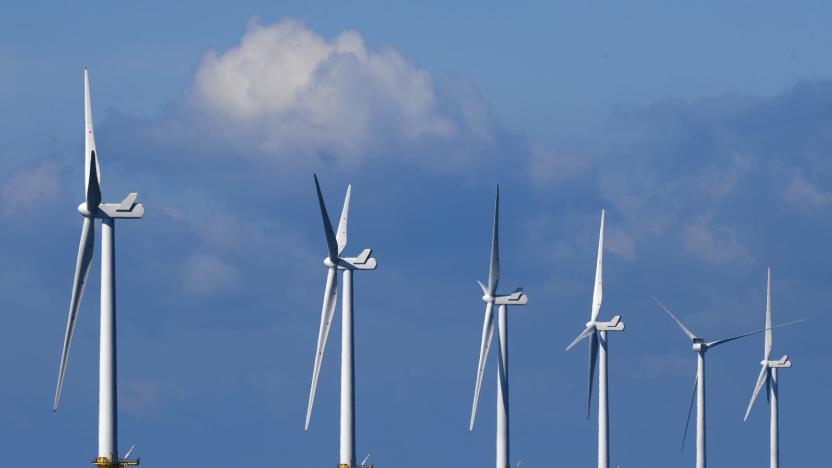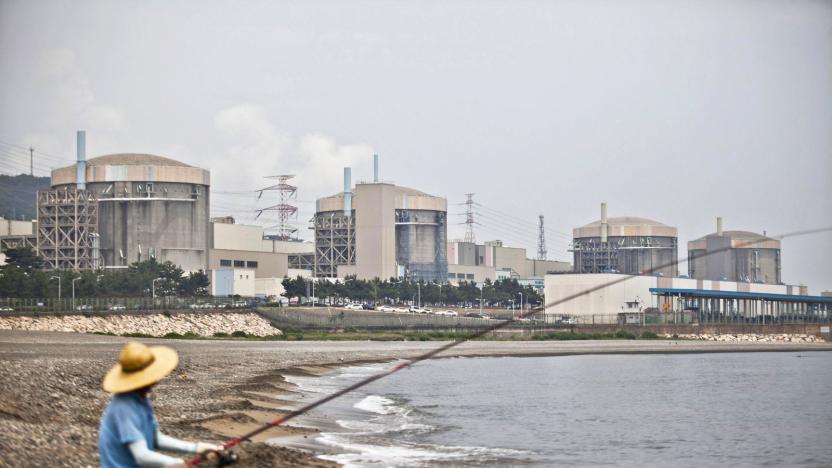NaturalGas
Latest

Renewable energy outstripped coal use in the UK for most of 2017
The UK has been working to significantly reduce its carbon emissions and with that effort, it hit some major green milestones this year. In April, the country went a full day without coal-generated power for the first time in 135 years. And in June, the country saw more than half of its energy being generated by renewables (i.e. solar, wind, hydropower and biomass) for the first time.

Rare metals could make hydrogen-powered cars more efficient
Despite being much faster to fuel up than EVs, hydrogen fuel cell-powered cars have largely failed to make an impact. There are various reasons for that like the crazy expensive infrastructure and hydrogen's explosiveness, but the main one is that from well to wheels, hydrogen cars are much less efficient than EVs. Now, researchers from Spain and Norway have unveiled a new method to convert methane to hydrogen with almost no loss of energy, perhaps making the vehicles (slightly) more feasible.

South Korea turns its back on coal and nuclear power
South Korea is clearly a tech-savvy country when companies like Samsung and LG dominate, but you almost wouldn't know it by looking at its energy policies. It not only depends heavily on coal and nuclear reactors (70 percent of its power comes from those sources), but gives them tax breaks to keep prices down. However, it's making an about-face now that there's a new president. New leader Moon Jae-in is proposing an energy strategy that would discourage the uses of coal and nuclear in favor of both natural gas and renewable sources like hydro and solar. It would be unusually rapid -- and not without potential problems.

UMaine's clean snowmobile runs on (a lot of) natural gas
Take a look at what these mechanical engineering students from the University of Maine say is the only natural gas-powered snowmobile in the US. Why make all these changes to what used to be a stock Arctic Cat XF1100? To compete in the Society of Automotive Engineers Clean Snowmobile Challenge, which was founded to create machines capable of running in Yellowstone Natural Park where rules about noise and emissions keep gas snowmobiles out. Changing the fuel source from gasoline to natural gas not only meant swapping out the gas tank, but also the injectors inside the motor. As you can see in the video after the break, last year's team got the beast running, but this year students are working on improving the handling and tuning.

Scientists find a way to make fracking less horrible for the environment
Using fracking (hydraulic fracturing) to get oil or gas may fulfill energy needs, but it has a nasty impact on the environment. Among other things, it leaves behind extremely salty water. However, scientists at both MIT and the King Fahd University of Petroleum and Minerals have found technology that could soften the blow. Their approach filters output water through multiple stages of electrodialysis, which uses electrical charges to pull salt through a membrane. This wouldn't make the water drinkable, but it would be reusable -- and that, in turn, would reduce or even eliminate the need for fresh water beyond an initial supply. Oil and gas wells wouldn't deprive local communities of nearly as much drinking or farming water, and they wouldn't have to dispose of quite so many contaminated liquids.

Boeing's SUGAR Freeze is a cool way to power a plane
No, not the sensation you get when you have gulped your ice cream too fast. SUGAR Freeze is the a new propulsion concept developed by Boeing that aims to revolutionize air travel. Standing for Subsonic Ultra Green Aircraft Research, the NASA-commissioned project (codenamed "N+4") looks at immature technologies in the hope of kickstarting research for the future. It's reportedly 60 percent more efficient than the equivalent Boeing 737-800, thanks to a very experimental propulsion system. Cryogenically stored liquified natural gas (hence "Freeze") is burned in a pair of unducted fan engines while also powering a solid-oxide fuel cell as an aft-thruster. With LNG projected to remain abundant, more environmentally friendly and cheap well into the century, it makes an ideal substitute to current aviation fuel, which is none of those things. Currently it's far too unsafe a design to contemplate building, and there are concerns about the natural gas production process, but hopes remain that the kinks will be ironed out well before the 2045 deadline.

Inhabitat's Week in Green: solar train tunnels, refillable battery goop, and the world's first 3D-printed bikini
Each week our friends at Inhabitat recap the week's most interesting green developments and clean tech news for us -- it's the Week in Green. This week green transportation left fossil fuels in the dust as Inhabitat reported that a record-breaking electric VW Bug rocketed from 0-60 in 1.6 seconds and Team Steam unveiled a space age vehicle that is vying for the title of "fastest steam car on earth." We also spotted the world's first natural gas-powered supercar, while a team of Cambridge students unveiled a sleek solar racer that will attempt to travel 1,800 miles in the World Solar Challenge. Oil fuels also lost more luster as GM's CEO called for a $1 gas tax increase in the US, while MIT unveiled a new type of liquid flow battery that could refuel electric vehicles in a snap. As the summer sun hits its stride groundbreaking solar power projects are lighting up left and right - this week Google unveiled a new solar patent that could make solar energy cheaper than coal, while QSolar rolled out an array of rainbow-hued Kristal panels that can replace windows and walls. Photovoltaic gadgets also had their moment in the sun as Pixel Qi pulled back the curtain on a cheap, efficient solar-powered tablet and a wave and sun-powered seafaring robot received $22 million in funding. Speaking of solar power, this week we applauded the opening of a two-mile-long photovoltaic train tunnel that will provide power to the Paris-Amsterdam high-speed rail line. We were also wowed by Steve Jobs' vision for Apple's new spaceship-shaped clean energy campus, and our Bright Ideas Lighting Design Competition is really heating up, so be sure to vote for your favorite green lamp before the contest ends next week. Finally, we shared 6 great green Father's Day gifts for tech-savvy dads, and as summer gets set to begin we brought you exclusive photos of the recently opened section 2 of New York's High Line park, a beautiful suspended swimmer's oasis in Denmark, and the world's first 3D-printed bikini.

GE announces hybrid power plant of the (near) future
GE's legacy dates back over a century, but, despite its old age, the company's got a fresh outlook on the future of energy production (at least according to its PR department). Earlier this week, the outfit announced MetCap Energy Investments' plans to build a "first-of-its-kind" hybrid power plant, tapping GE's FlexEfficiency technology, which combines natural gas, wind, and solar thermal power. The plant, planned for completion in Turkey in 2015, will produce enough energy, according to GE, to power 600,000 homes, and could lead to plant efficiency greater than 70 percent. What's more, the company promises zero liquid discharge and single-button 28-minute startup. Here's hoping this cracks up to be a better fit than NBC. Full PR after the break.

Google helps electric car owners find battery charges, peace of mind
The biggest challenge of owning an electric vehicle aside from having to awkwardly pal around with Ed Begley Jr. all of the time? Finding a place to charge it, of course. The ever-green folks at Google have teamed up with the US Department of Energy and more than 80 companies to form the GeoEVSE Forum, an organization aimed at bringing diverse electric car resources under a single umbrella. Looking for one of those elusive Best Buy charging stations? Use the Google Maps database, helmed by the DOE, which currently offers some 600 alternative fueling stations, including electric charging, hydrogen, and natural gas. Now if only it could help us find a good deal on a Tesla.

Yo-mobile hybrid cars on display in Russia, run on gas, natural gas, and GLONASS
The Yo-mobile (or ë-mobile if you're down with Cyrillic) is looking to shake things up on the eastern front, and after big-bucks backer Mikhail D. Prokhorov introduced the car to the world last month he's now letting members of the proletariat see the car for themselves at the Yo-mobile Hybrid Pavilion, where three models of the car are being shown to the public: the microcar (wee hatchback on the right above), a coupe, and even a minitruck. All are now said to start testing in the coming months, and we're just learning that the car will feature GLONASS navigation, is said to include a "telephone with a keyboard" and will have some sort of infotainment system controlled by a "data panel," which we're hoping is a little better integrated into the dash than the slab dominating the Model S center console. Again the hybrid makes up to 67 miles per gallon with a range of a whopping 680 miles if both its gasoline and natural gas tanks are filled, which also gives owners two potential fuel sources for fleeing the oncoming zombie hoards.

Philadelphia Eagles going self-sufficient on stadium energy from 2011, 30 percent of it renewable
Let's skip right past the cringe-worthy "Declaration of Energy Independence" slogan and look at what the Eagles are actually doing with their pro sports venue. The franchise that dresses in midnight green is aiming to smarten up its eco-green credentials with a new partnership with SolarBlue that will provide all of the Eagles' stadium energy needs for the next 20 years, after which point the team will be free to resell any surplus electricity back to the grid. 15 percent of the total output with be generated with spiral wind turbines erected around the top rim of Lincoln Financial Field, another 15 will come from 2,500 solar panels to be installed near the stadium, and the rest will be obtained from a biodiesel / natural gas plant. So it's not all renewable, but a nice step in the right direction, nonetheless.

Corncob waste could enable methane use in vehicles
Aside from the obvious choice, there's vehicles scooting around on bioethanol, batteries, fuel cells, and all sorts of other alternatives, but a recent breakthrough in Kansas City, Missouri has opened up the possibility of using natural gas. Currently, the cheaper and cleaner burning methane isn't feasible in modern vehicles due to the extremely high pressure (3,600 psi) and gargantuous tanks required to actually use it. Researchers at the University of Missouri-Columbia and Midwest Research Institute in Kansas City have devised a way to change all that, however, by using corncob waste to create "carbon briquettes with complex nanopores capable of storing natural gas at an unprecedented density of 180 times their own volume and at one seventh the pressure of conventional natural gas tanks." In layman's terms, this discovery allows natural gas to be held under much less pressure and in thin-walled tanks similar to cells used on current vehicles, which could instantly make natural gas a viable (and readily available) alternative fuel source. A prototype system has been working just fine since last October, and the backers are currently crafting a second revision in hopes of storing even more natural gas and driving production costs down, but there's still no hard deets on when this invention could see commercial light.[Via AutoblogGreen]








